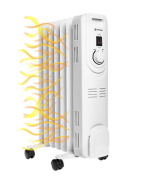HawkinsHollow
Veteran Member
It is obvious prices are on the rise. It is not awful yet, but some think it will get considerably worse. I am not one to get caught with my pants down. SO, I was hoping to gain some insight on things y'all are doing or plan on doing to make the blow not quite as bad.
I am in pretty good shape, better than most probably but we can always do more.
Some things that I am planning on doing or everyday life things that help my situation.
Heating - We live in the SE TN so heating costs are not a huge issue. We have a reasonably efficient heat pump as our main source of heat. On top of that we also have a wood stove in our living room that we use to supplement in the winter. When it is cold and I am home like on weekends our heat pump doesn't run. NEW PROCEDURE - I also plan on running an oil filled radiator during the week while my wife is home so the heat pump doesn't have to work too hard. Probably one in her office and one in the main living space.
Transportation - We both drive 28 to 30 mpg vehicles as our daily drivers, so that helps. And my commute to work is 4 miles, wife works from home. My farm truck is a 85 F250 that get 7 mpg, not much I can do about that except drive it only when necessary.
Food Stuffs- Prices of food are on the rise. Beef and other meats are following right along. I have a deer and a half in the freezer and half a wild boar. Hopefully put another deer in there soon. Also plan on doing the usual gardening this spring. Hopefully seeds will not be in short supply. Might even start it out a little early this year with a cold frame or DIY greenhouse.
Those are the things I have thought about so far. What else have y'all thought about to help ease the sting of rising prices. REALLY value the collective braintrust that is TBN. What are you doing/gonna do different?
I am in pretty good shape, better than most probably but we can always do more.
Some things that I am planning on doing or everyday life things that help my situation.
Heating - We live in the SE TN so heating costs are not a huge issue. We have a reasonably efficient heat pump as our main source of heat. On top of that we also have a wood stove in our living room that we use to supplement in the winter. When it is cold and I am home like on weekends our heat pump doesn't run. NEW PROCEDURE - I also plan on running an oil filled radiator during the week while my wife is home so the heat pump doesn't have to work too hard. Probably one in her office and one in the main living space.
Transportation - We both drive 28 to 30 mpg vehicles as our daily drivers, so that helps. And my commute to work is 4 miles, wife works from home. My farm truck is a 85 F250 that get 7 mpg, not much I can do about that except drive it only when necessary.
Food Stuffs- Prices of food are on the rise. Beef and other meats are following right along. I have a deer and a half in the freezer and half a wild boar. Hopefully put another deer in there soon. Also plan on doing the usual gardening this spring. Hopefully seeds will not be in short supply. Might even start it out a little early this year with a cold frame or DIY greenhouse.
Those are the things I have thought about so far. What else have y'all thought about to help ease the sting of rising prices. REALLY value the collective braintrust that is TBN. What are you doing/gonna do different?
